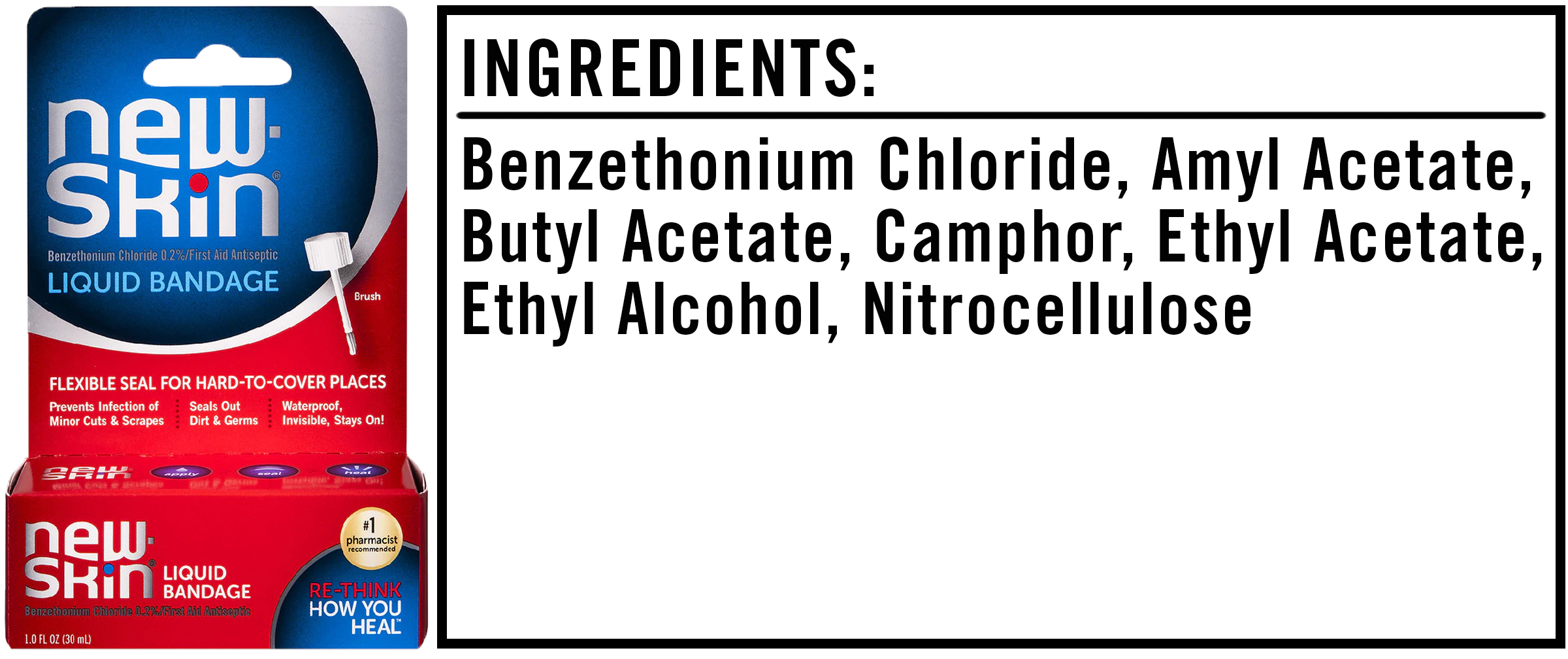We’re often told that you should never eat anything (or put anything on your body) if you don’t recognize everything on the ingredients list. But since most of us have no idea what xanthan gum or potassium benzoate are — or more importantly, what they’re doing to our bodies — we’re decoding the ingredients in the many things Americans put in (and on, or near) themselves.
This edition: New-Skin Liquid Bandages, which are made from eight ingredients that we’ve broken down as they appear on the Walmart website.
The Ingredients
1) Benzethonium Chloride: Used as a topical antimicrobial agent in first-aid products, benzethonium chloride — the only active ingredient in these liquid bandages — dries to form a waterproof protective seal over the skin. It can be used to protect minor cuts and scrapes while they heal (deep wounds should be inspected by a doctor), and it can be removed by applying more liquid bandage to the area and quickly wiping it off.
While a small percentage of people may experience an allergic reaction (hives or swelling) to benzethonium chloride, common side effects include burning or stinging when the liquid bandage is applied. So, if you feel some immediate stinging, try not to freak out.
2) Amyl Acetate: Amyl acetate is a solvent, which means it dissolves or disperses the different components in these liquid bandages, making them a desired consistency for application. Once applied, the amyl acetate evaporates, allowing the benzethonium chloride to produce an even film over the skin and dry quickly.
3) Butyl Acetate: Another solvent, butyl acetate also has a quick drying time. It can be found naturally in many fruits. Note, however, that butyl acetate is highly flammable, so keep your freshly bandaged skin away from fires.
4) Camphor: Camphor is typically derived from camphor trees — although it comes in synthetic variations, too — and has a menthol-like, nose-tingling fragrance. It can be used to relieve skin irritation and itchiness, and it has antibacterial and antifungal properties that may make it useful for healing infections.
5) Ethyl Acetate: Another solvent, ethyl acetate is both flammable and can cause irritation to the skin.
6) Ethyl Alcohol: Ethyl alcohol is responsible for killing any bacteria that may be lingering underneath your liquid bandage. It basically helps prevent infections from stewing.
7) Nitrocellulose: Nitrocellulose, also known as guncotton, is highly flammable and commonly used as a mild explosive. In the context of liquid Band-Aids, it provides flexibility and softness.
8) SD Alcohol 3-C: A denatured alcohol, or ethanol mixed with another chemical — isopropyl alcohol in this case — SD alcohol 3-C is added to make these liquid bandages unpalatable, something the government requires for inedible alcohol products to prevent people from making them into booze. (Not that liquid bandage booze would be any good, anyway.)
The Takeaway
Generally speaking, liquid bandages are good for areas where regular bandages tend to fall off of — think fingers, elbows, knees, etc. But avoid using them around your eyes, ears, nose or mouth. Keep in mind also that there are some ingredients in these Band-Aids that may cause irritation — the numerous solvents, primarily — so you should probably try them out on some small areas of skin before going too crazy. Otherwise, though, get healed, bro.


